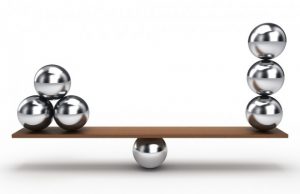
Let's start with the fact that balance “range balance” is not just all or nothing. Your used ranges do not necessarily have to be perfect; it is certainly not necessary to maintain that perfect proportion we mentioned in the previous article. Let's talk about imperfections. In a real poker game, the information that includes your used hands is received by opponents very, very slowly. Think about it – they see one hand per showdown, and most hands in poker are not even revealed. Moreover, it takes time for an opponent to see a hand that reveals a lot of distinctive information about your game. Thousands of hands may pass before they see a hand that confirms or denies their initial information. Most of your used range will remain unknown for a long time because such information is collected very slowly in real poker, so you can do what you want until your opponent realizes what's happening and starts reacting accordingly.
Not only is information in poker imperfect, but people also like to react to it imperfectly. For example, even if your opponent catches you bluffing, you don't need to prove to them that you have enough strong hands to make them respect you again. Usually, it's enough to show that you have a few. If your opponent suddenly sees the nuts in an unusual situation where you previously bluffed, they won't chase you in that situation anymore because they will conclude that you have adjusted your game and your range and are no longer bluffing. Strong conclusions of this type are often made from such vivid observations. Instead of thinking, “Yes, I saw the nuts once, and the other eight times it was a bluff, so his range consists of 89% bluffs,” the opponent will think that you have completely changed your strategy. After that, they will need to see a significant number of hands to be convinced that you don't have enough nuts in your range to make you unbeatable. All this happens not only because of unclear and slowly collected information but also because vivid situations (such as seeing a strong card) are more memorable than slowly collected data.
Very often, in an attempt to balance their range, players make a big mistake by thinking that the other player thinks the same way they do. Even that they see the whole situation the same way they do. This is one of the biggest mistakes a poker player can make and why they give up profitable bluffs.
For example, let's say we are in a situation where we are considering making the following move: a 3-bet bluff on the river, showing a runner-runner straight, which is far from the center. When considering such a bluff, you might realize that you would never have a straight here because you would have played differently from the start. You might also start thinking that it's irrational because a straight is played differently altogether. This is the mistake of thinking that the other player sees everything through your eyes. The point is that even if they think the same way you do, they can't know if you always play a backdoor straight this way. It could be that they haven't had the chance to analyze such data about your game at all. Even better, maybe they didn't notice when such information was right in front of them; maybe they saw it but forgot. There are many stages of information gathering between what you notice and what the other player notices. You have to remember this; otherwise, you will lose many profitable situations that are just begging for a bluff.
There are important and obvious exceptions to this rule where an unexploitable and “perfect” balance is important. These are situations where information gathering is unstable and very fast. For example, in any situation close to the center, such as preflop 3-betting, you won't get away with a 3-bet with a poor hand. Your opponents will quickly note such behavior and react to it very quickly. But the further away from the center the situation is, the harder it is to gather information, making it harder to react quickly, adding more psychological subtleties, and making you less noticeable and harder to exploit.





